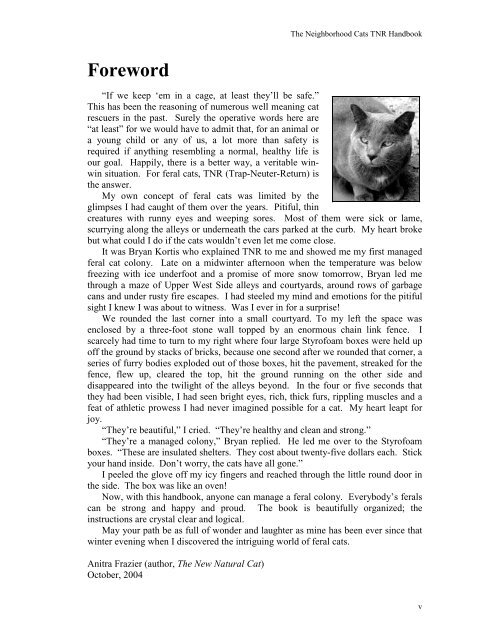Create successful ePaper yourself
Turn your PDF publications into a flip-book with our unique Google optimized e-Paper software.
Foreword<br />
The <strong>Neighborhood</strong> <strong>Cats</strong> <strong>TNR</strong> <strong>Handbook</strong><br />
“If we keep ‘em in a cage, at least they’ll be safe.”<br />
This has been the reasoning of numerous well meaning cat<br />
rescuers in the past. Surely the operative words here are<br />
“at least” for we would have to admit that, for an animal or<br />
a young child or any of us, a lot more than safety is<br />
required if anything resembling a normal, healthy life is<br />
our goal. Happily, there is a better way, a veritable winwin<br />
situation. For feral cats, <strong>TNR</strong> (Trap-Neuter-Return) is<br />
the answer.<br />
My own concept of feral cats was limited by the<br />
glimpses I had caught of them over the years. Pitiful, thin<br />
creatures with runny eyes and weeping sores. Most of them were sick or lame,<br />
scurrying along the alleys or underneath the cars parked at the curb. My heart broke<br />
but what could I do if the cats wouldn’t even let me come close.<br />
It was Bryan Kortis who explained <strong>TNR</strong> to me and showed me my first managed<br />
feral cat colony. Late on a midwinter afternoon when the temperature was below<br />
freezing with ice underfoot and a promise of more snow tomorrow, Bryan led me<br />
through a maze of Upper West Side alleys and courtyards, around rows of garbage<br />
cans and under rusty fire escapes. I had steeled my mind and emotions for the pitiful<br />
sight I knew I was about to witness. Was I ever in for a surprise!<br />
We rounded the last corner into a small courtyard. To my left the space was<br />
enclosed by a three-foot stone wall topped by an enormous chain link fence. I<br />
scarcely had time to turn to my right where four large Styrofoam boxes were held up<br />
off the ground by stacks of bricks, because one second after we rounded that corner, a<br />
series of furry bodies exploded out of those boxes, hit the pavement, streaked for the<br />
fence, flew up, cleared the top, hit the ground running on the other side and<br />
disappeared into the twilight of the alleys beyond. In the four or five seconds that<br />
they had been visible, I had seen bright eyes, rich, thick furs, rippling muscles and a<br />
feat of athletic prowess I had never imagined possible for a cat. My heart leapt for<br />
joy.<br />
“They’re beautiful,” I cried. “They’re healthy and clean and strong.”<br />
“They’re a managed colony,” Bryan replied. He led me over to the Styrofoam<br />
boxes. “These are insulated shelters. They cost about twenty-five dollars each. Stick<br />
your hand inside. Don’t worry, the cats have all gone.”<br />
I peeled the glove off my icy fingers and reached through the little round door in<br />
the side. The box was like an oven!<br />
Now, with this handbook, anyone can manage a feral colony. Everybody’s ferals<br />
can be strong and happy and proud. The book is beautifully organized; the<br />
instructions are crystal clear and logical.<br />
May your path be as full of wonder and laughter as mine has been ever since that<br />
winter evening when I discovered the intriguing world of feral cats.<br />
Anitra Frazier (author, The New Natural Cat)<br />
October, 2004<br />
v


